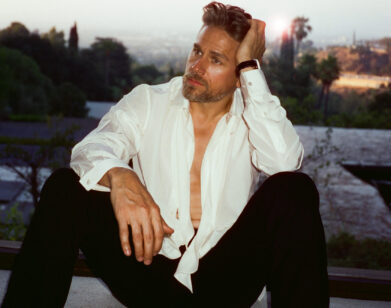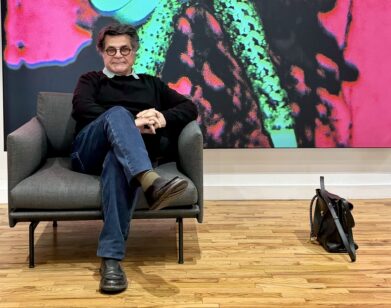Press Shots of Bill Cunningham

In the new documentary, Bill Cunningham New York, Vogue editor-in-chief Anna Wintour says, “we all get dressed for Bill.” The film’s director, Richard Press, however, does not.
“No,” he says. “I have my little uniform. It’s very minimalist. I just kind of wear the same thing every day.” Press’s ethos is similar to that of the documentary’s subject, the iconic New York Times photographer who is known for maintaining a monotonous style while photographing the city’s originals. Matching uniform for uniform, Press followed Cunningham—who hasn’t seen the movie, according to the director—around to create a film that shows Cunningham on the street, at New York parties, and in his home. In doing so, he writes a cultural history of the city, revolving around one of its most faithful chroniclers.
We talked to Press about making the film, New York, and cyclists.
ESTHER ZUCKERMAN: When did you first see a Bill Cunningham photograph?
RICHARD PRESS: God, I mean, I grew up in New York, so I grew up reading the Sunday Times. It’s always something I’ve been aware of, since my childhood.
ZUCKERMAN: What made you decide you wanted to make this film, though?
PRESS: I always have admired what Bill does, his body of work. I think it’s a really important, seminal body of work. For me, the impetus of the film was really trying to capture this very singular individual. It was really about who Bill is as a person, how he’s chosen to live his life, his worth ethic, his kind of religious dedication to his work, his morals. It was really about trying to capture a really rare bird. There were other threads that were important to me, because I think Bill celebrates creativity and self-expression, and I want the movie to be about that as well and be a celebration of New York. So it’s really a lot of different kind of threads, all through the lens of Bill Cunningham.
ZUCKERMAN: Did you know anything about Bill’s somewhat reclusive life or his history when you decided you wanted to make the film?
PRESS: I actually didn’t. I knew Bill personally, in the way that most people know him—you don’t really know that much about him. So I had never been in his apartment, as most people hadn’t. I really had no idea how he lived. I knew he lived in Carnegie Hall, but that was it, and I didn’t really understand. I knew that he worked hard, I just didn’t realize that that was what he does, that’s basically all he does. Kind of the slow revealing of the person in the movie was also the filmmakers discovering him.
ZUCKERMAN: When did you first meet Bill?
PRESS: When I first started making films—this is my first feature, but I was making shorts—I was actually freelancing as a day job at The New York Times as an art director. I actually worked with Bill over 10 years ago. I did his page for him, with him, so that’s how I got to know him; and really soon after I met him, I thought, “Oh my God, he’s a perfect subject for a documentary.” And Philip Gefter, who’s the producer of the film who is also my partner, he was working at the Times as an editor and he knew Bill. I said to Philip, “We need to make a movie about this guy,” and we dragged Bill into a conference room and proposed this idea, and he just thought it was the most ridiculous thing, he was just laughing. As you probably know, it took 10 years to make, and I say eight of those years were spent trying to persuade Bill to let us do it.
ZUCKERMAN: I read that it was an interesting experience working with Bill to make the film. What was the process of shooting like?
PRESS: It was pretty unconventional, in the sense of how you normally make a movie. He would not have allowed a film crew. The movie could not have been made with a sound person and a boom operator and a typical cinematographer. It couldn’t look like a movie was being made. He just wouldn’t allow that kind of attention. It had to be a very intimate thing. So it was myself shooting; Tony Cenicola, who is a staff photographer at the New York Times, who Bill knows and likes very much was the other cinematographer; and Philip Gefter, the producer.
We were shooting with very small, pro-consumer cameras. They could fit in your hand. It didn’t look like I was making a movie. I was just hanging out. I just lived at the New York Times for a year, trying to just capture him when he would allow us to film him. It was really scary for me to be making a movie where there wasn’t a professional sound person, and we were basically just using mics that were on the camera and occasionally, Bill would let me pin one of those little wireless things on his collar, but very rarely. It was making it, in a way, under very challenging circumstances, but I think as a result there’s an intimacy there that just wouldn’t have happened had it been a traditional movie shoot.
ZUCKERMAN: The film is called Bill Cunningham New York. I think it’s interesting that there is no punctuation in the title. Do you think Bill Cunningham could exist without New York?
PRESS: In a certain way, they are one in the same. He has been documenting the intersection of fashion and society and culture in New York for the last 50 years, and so if you want to know what New York is and how we live and who we are… look at Bill Cunningham’s photographs. I don’t think any other city actually has anyone who has actually documented the way they have lived or documented the city themselves. If you want to look at New York in the last half of the 20th century, into the 21st, you would look at Bill Cunningham’s archives. It is a kind of singular thing, and the title was very conscious on my part that it is “Bill Cunningham New York” because it’s like an address—like “Bill Cunningham New York” is a place, it’s a thing, they are one and the same.
ZUCKERMAN: There’s a lot of the film that felt very nostalgic to me. Did you intend it to come off that way, with Carnegie Hall or the early Details magazine?
PRESS: I think I wanted to capture something that I think is dying, at least in this part of the city, because of economics and because of trying to focus on real estate and Wall Street. I think this kind of bohemianism doesn’t really exist in the city anymore—the bohemianism that I was trying to record in Carnegie Hall that completely defined our culture. The people who lived and worked in Carnegie Hall studios, they defined our culture in music, dance, theater, fashion, illustration. It wasn’t so much nostalgic as a celebration of that and an acknowledgment of that and saying that it’s really important. And it’s actually something that is a loss for the city, I think.
ZUCKERMAN: I fell in love with Editta [Sherman].
PRESS: Yeah. 96 years old, this amazing spirit. I just thought these were remarkable people who needed to be documented. I think that’s true for so many people in the movie, like Patrick McDonald and Iris Apfel. These are people who Bill has been photographing over the years, but they also just represent this celebration of self-expression and self-creation that is really important and I think is something that Bill celebrates. I was trying to have the movie be a celebration about that.
ZUCKERMAN: New York has become a friendlier place for cyclists. How do you think Bill feels about this?
PRESS: I think he probably thinks it’s great. I don’t know how much thought he gives it. I think he’s the kind of pioneer of that.
BILL CUNNINGHAM NEW YORK OPENS AT FILM FORUM IN NEW YORK TOMORROW AND AT NUART IN LOS ANGELES ON MARCH 25, BEFORE OPENING AROUND THE COUNTRY. FOR MORE INFORMATION, CLICK HERE.






